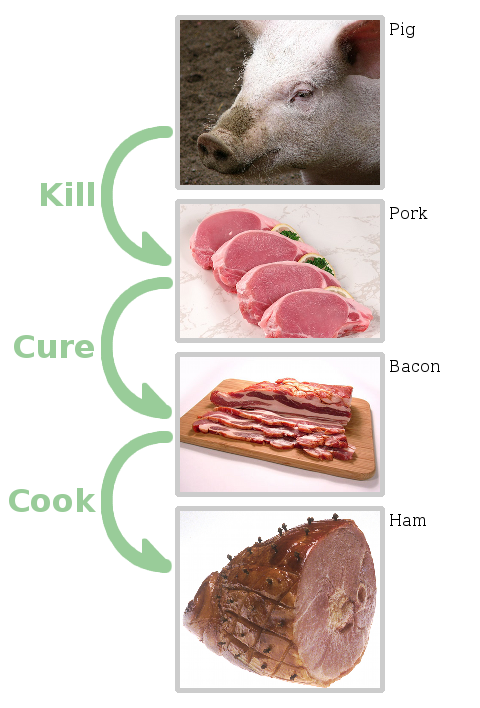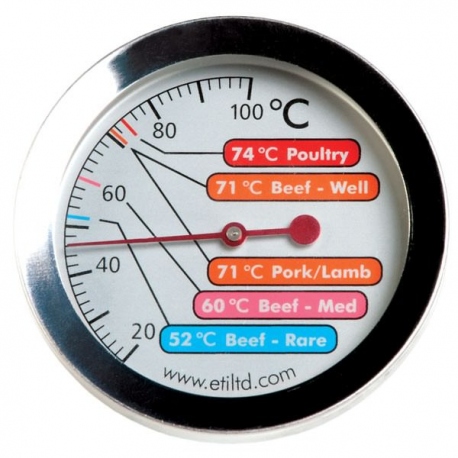Lamb is a great meat to use in slow cooking....
Read More
1. What is Gammon?
The word ‘gammon’ descends from the Middle English ‘gambon’ meaning ham. As a word, gambon has been in use since at least the 15th century, itself coming from the older French word ‘jambon’ (which should be familiar to anybody with GCSE French under their belts). The French word jambon derives from the Latin ‘gamba’, which literally means ‘leg of a horse/animal’. So, as you can see, we humans have been eating gammon for a long, long time!
So what is gammon and how is it produced?
Gammon is meat from the hind legs of a pig that has been cured the same way as bacon.
The meat is cured, either by dry salting or by brining. Salting allows the meat to mature safely via the addition of salt. This draws out the moisture and gives the meat a slightly salty flavour. Brining, on the other hand, keeps the meat as moist as possible while it matures.
After curing, the gammon may be smoked or un-smoked. Smoked gammon has a stronger flavour overall and therefore has the edge in terms of taste, while un-smoked sits a little more delicately on the palette.
The quality of gammon available varies widely. Intensive farming methods can often lead to animal cruelty and poor quality meat. Look for a quality assurance stamp whenever you buy.
TIP: if your dinner guests include vegetarians and/or vegans, a few gammon substitutes are available. These have been designed to replicate the taste of ham and are made with wheat, protein, potato starch and soya.
2. What’s the Difference Between Gammon and Ham?
As we’ve seen, the word ‘gammon’ means ‘ham’ (more or less, anyway). Ham, as you’re no doubt aware, is also meat from the hind legs of a pig.
…So what’s the difference between gammon and ham?
The main difference between the two is that gammon is sold un-cooked and ham (being first dry-cured or otherwise cooked) is sold ‘ready to eat’.
Gammon is cured in the same way as bacon, which also needs cooking first.
Now, to pre-empt the obvious question; yes, once you’ve cooked your gammon, it can then be simply known as ‘ham’.
TIP: We all know someone who insists that raw bacon is safe to eat. The truth is that eating any raw or undercooked pork is incredibly risky, even if it has first been cured and/or smoked.
…Unless of course you like the idea of gaining a parasitic infection known as trichinellosis that causes acute sickness, diarrhea, fever and abdominal pains which can last for months.

3. How long to Cook Gammon in Slow Cooker
To boil (the most common method), take a water-filled pan big enough to fully submerge the gammon, then place the meat into the water and slowly bring it to the boil. The weight of the gammon will determine the cooking time required.
Generally speaking, you’ll want 20 minutes of cooking time per 450g (or 1lb), plus an additional 20. Beware of overcooking, as this can ruin the food.
When the meat is ready, haul it out carefully and place it on a chopping board. Ensure that it is thoroughly cooked, then remove the fat and serve.
TIP: Do not tip the water away immediately. Firstly, it will be very, very hot at this point and secondly, you might need to return the meat to the water if it isn’t 100% ready.
To roast, simply cover the meat in honey or maple syrup (soy sauce is also an option, although this can make it a little too salty for some), then wrap it entirely in kitchen foil and roast in the oven. For roasting, you’ll need about 30 minutes of cooking time per 450g/1lb, plus an additional 20.
You can also par-boil the meat for half the time, then roast it for the rest, creating a meal that has the great flavour of a roast, but retains the moisture of boiled meat.
TIP: Once cooked, gammon ham is delicious cold, and makes a great addition to a salad or a sandwich (especially with mature cheddar and smoky BBQ sauce!). The meat can also be re-heated, as long as it is cooked right through.
4. Slow Cooked Gammon
Slow cookers are perfect for cooking gammon. You can add ingredients like onions, cinnamon, orange and/or honey. Gammon works well with warming spices, too. Be prepared to wait around 8 hours for your meal though.
Once the meat has cooked through, let it cool down in the liquid for a while. This stops the juices from running out.
TIP: Don’t lift the lid whilst the meat is cooking, as this allows valuable heat and moisture to escape and can add as much as 30 minutes on to your overall cooking time.
5. How can I tell if the Gammon is Cooked?
Meat temperature gauges are available, but if you don’t own one, don’t worry.
If you aren’t 100% sure that your gammon is cooked right through (i.e. if it now qualifies as a ‘ham’ or not), simply take a knife and push it into the middle of the meat, holding it there for 5 seconds or so.
After this, remove the blade, then carefully press your fingers to the side or top of it (avoiding the sharp bit, obviously). If it feels hot to the touch, then your meat is most likely cooked. If not, simply pop the gammon back in the water and try again in a few minutes, making sure that next time you check, you poke the meat in a different spot.

6. What to Serve with Gammon
One of the great selling points of gammon is its versatility; it makes a great early or mid-week meal, as a good sized joint can last a couple of dinners and lunches without ever feeling repetitive or boring.
Gammon tastes great with pasta in a rich, Italian style tomato sauce. It is even greater when baked into a pie with roast turkey and gravy and served with all the trimmings.
Gammon can be served with parsley sauce, creamy mash, jacket potatoes, lentils or broccoli. It also goes well with peas, asparagus, carrots, sweet potato mash (make it with butter, milk, coriander and assorted spices)…And these are just some basic suggestions.
TIP: Try to pair gammon with foods that are low in salt, as gammon has a high sodium content due to the method of curing. Serve it with green vegetables and/or salad, as this creates a nice, healthy balance.
7. Nutritional Benefits of Gammon
Gammon is a great source of ‘B’ vitamins, especially B1 (thiamine), B2 (riboflavin), B3 (niacin) and B6 (pyridoxine). It is also chock full of protein (containing something like 30% more than most fresh meats), which is great for strength and especially good for children.
This delicious cured meat is rich in iron, magnesium and zinc, as well as potassium, phosphorus, copper and selenium.
Gammon also has a high concentration of amino acids (essential for growth).
On the negative side, this food is very high in sodium (too much salt in your diet can be quite destructive, especially to children) and also quite high in cholesterol. You will need to balance it alongside other, less fatty and/or salty foods.
Slow Cooker Gammon Recipes
How to Cook Gammon in the Slow Cooker
- 1 – 1.5kg Gammon Joint
- 2 Onions
- 2 Carrots
- 2 Tablespoon Thyme
- 1 Teaspoon Garlic Puree
Slow Cooker Gammon in Ginger Beer
- 1 – 1.5 kg Gammon Joint
- 2 Onions
- 1 Tablespoon Ginger Puree
- 2 Tablespoon Soy Sauce
- 1 Tablespoon Worcester Sauce
- 300ml Ginger Beer
Honey and Mustard Slow Cooker Ham
- 1 – 1.5 KG Gammon/Ham Joint
- 2 White Onions
- 3 Tablespoons of Brown sugar
- 3 Tablespoons of Honey
- 2 Tablespoons of Mustard (Dijon/Coarse-Grain)
- 1 Tablespoon of Cloves
How to Cook a Gammon Joint in a Slow Cooker with Water
- 1.5 – 2 kg Gammon Joint (unsalted)
- 1 x White Onion
- 2 x Carrots
- 1 x Cinnamon Stick
- 1 Tablespoon of Cardamoms
- 1 tablespoon of Cloves
- 200ml White Wine
Other Stuff You'll be Interested In
5 Best Slow Cooker Beef Bourguignon Recipes
What is Beef Bourguignon Beef bourguignon is considered a classic...
Read More5 Best Slow Cooker Butter Chicken Recipes
What is Butter Chicken? Butter Chicken or murg makhana originated...
Read More